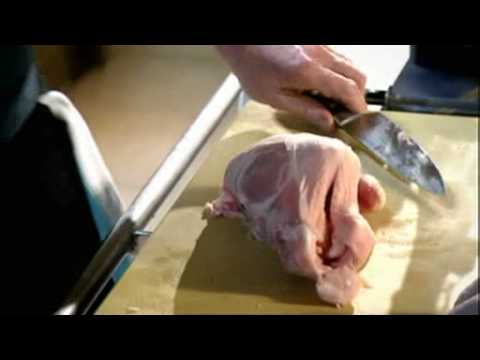I have done a few. I have tried a couple of methods.
If you choose to use a axe, make sure it is sharp, and you are using a block. I believe the bird won't feel pain if it's head is not connected to the body, but it's not the cleanest way, and I found it wasted some of the neck.(We have always fed our dog bought chicken necks so I was never going to waste them off our own butchered birds)
The method I have been using with the most satisfaction is the cone and bleed method. My description may be graphic, so if you are not comfortable with detail don't bother to read on.
I made a kill cone from some plastic garden mesh. Just zip tied it into the shape I wanted. This is important as it restricts the birds movement once the nerves kick in, it also holds the bird in position for the process. I hang the bird by it's legs, then feed the cone up from the head end and zip tie the feet to the cone. Ensure the head is clear of the cone, yet the wings are 'hugged' Hold the head with your non master hand and the beak facing you. Using a very sharp knife (I will come back to the knife in a moment) cut from just above the ear lobe to the center of the throat. One side is normally enough, but I swap hands and cut the other side too. You will get some blood on your non master hand as you hold the head. The bird may thrash a little in the cone. I hold the head until the bird is motionless (only take a few seconds) There is not a very large amount of blood, but you need to ensure you cut deep enough that the blood flows at a reasonable dribble. If it does not, you have missed the main artery and may need to make another cut.
The knife. I cannot stress enough about having a sharp knife. I blunt knife make the job hard, and is cruel to the bird. This cut is best made in one long stroke, so best to choose a sharp knife that has some length to the blade, like a filleting knife. Short blade like box cutters and razor blades work, but often require a second pass. I find a longer blade takes care of the job more briskly.
I also find that it's best to be prepared for the whole task.
Lay out your area, I presume you will be hand plucking, so you need a space for that, something to put your offel and rubbish in, water both hot and cold as well as a place to do the deed. Since you will be handling food, also make sure your tool and work space is clean, I use a weak bleach and water mix.
I lay all this out, I have a old sink, a hose, a drain bucket as well as a bin with a bin bag in it ready to go. I boil a big pot of water (big enough to stick a chicken into whole) and have that set aside ready. I have the hose handy as ready at the pressure I like to work with. All of this is done before I even go near a bird.
Once everything is ready, I grab one bird (some may choose to fast them to reduce mess from the crop, but I let them go) I leave the run, once out of sight of the flock I hold him by his legs and hang him by his feet. Fit the cone, bleed out and leave for another minute or so to ensure it is dead. I then remove from the cone and take to the cleaning area.
Firstly I take off the head as high up as possible.
I then dunk and hold in the hot water. There are temps floating around on the net, but I just adjust how long they are in. Remove and start to pluck. If it's in too long, then skin will tear, if it too short it's really hard to get the wing feathers out. Pluck. Make sure your work area is a comfortable height. This took me ages to start with, and it was a black bird too, so it took some rinsing to clean the little feather bits off. I then remove the legs
Once you are happy with the feathers, I gut the bird, remove the neck and feet are normally last (they make good handles I find) Try not to cut through bone, always go through the joint. In the case of the legs I make a cut across the front side, then gently bend it backwards opening the cut you just made and slice through the joint, easy, quick and no waste. Finally I remove the neck.
Sometimes I choose to skin the bird, in that case plucking can be a little less accurate, sometime I also part the bird out to make it easier to freeze. There is a great video on youtube of Gordon Ramsey doing this if you choose to.
Finally, give everything a good clean, knives, hose hand piece, bench tops the lot. Some people rest their bird in the fridge for a day or so, some freeze some eat straight away. Up to you.
I will also say, it tastes a bit different to store bought. A bit more 'earthy' and rich, and is also a bit tougher, so cook it nice and slow. In all honesty, it's probably exactly what chicken should taste like, not the watered down intensively raised version we are accustomed too.




